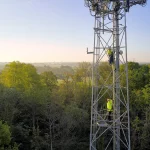London ISP Community Fibre Cuts Business 10Gbps Plan to £300

One of our readers has spotted that London broadband ISP CommunityFibre appears to have significantly discounted some of their UK business plans, which for example means that their top 10Gbps (8.6Gbps average speed) tier can now be taken for just £350 per month +vat on a 36-month term (previously £730) or £300 for 60-months.
The operator, which also owns Box Broadband – a similar network that targets Surrey and West Sussex in England (here), has already rolled out their own 10Gbps capable Fibre-to-the-Premises (FTTP) network to over 1 million homes and 212,000 businesses in London by the end of July 2023. CF were also aiming to reach 2.2m by the end of 2024, but that target is likely to suffer after recent job cuts and a build pause (here).
Instead, CFBusiness has pivoted to focus more on their marketing and sales, which might help to explain the latest offers on their business plans. At the same time, the provider’s latest discounts may also be a response to growing competition from similarly affordable rivals (e.g. Vorboss).
Advertisement
New customers of their various business tiers, which offers symmetric speeds from 150Mbps and all the way up to 10Gbps, will benefit from an 8-hour fix time, prioritised business support, unlimited data, a static IP address, a pledge of “no peak-time slowdowns“, a named account manager, broadband failure backup (4G mobile WiFi solution) and the usual array of SLA / service guarantees.
The CFBusiness plans also pledge that their prices will remain “fixed in 2024“, before increasing every April by CPI (i.e. the inflation figures as published in January) + 2.9%. But this will most likely have to be changed after Ofcom’s recent move to ban mid-contract hikes that are linked to inflation or percentage-based rises.
However, there is also the catch that the provider’s latest pricing appears to be a special offer, which means that businesses will pay more post-contract. For example, the top 10Gbps plan will return to its now standard price of £880 per month after the first minimum term period has ended. Customers also need to pay a one-off connection fee, with ranges from £200 on their 150Mbps tier and goes up to £695 for their top 10Gbps package.
Remember, these are all business plans and so are not comparable with CF’s residential services, which lack SLAs, Static IPs and typically share more of their capacity between many users.
Advertisement
Mark is a professional technology writer, IT consultant and computer engineer from Dorset (England), he also founded ISPreview in 1999 and enjoys analysing the latest telecoms and broadband developments. Find me on X (Twitter), Mastodon, Facebook, BlueSky, Threads.net and Linkedin.
« ISP Ogi Boost FTTP Broadband Speeds and Cuts Prices in Wales UPDATE
ISP BT Launch January 2024 Sale on UK FTTP Broadband Plans »






















































Im really interested in understanding better how these products compare to a conventional leased line product which is supposedly connected directly to the internet.
I.e. totally appreciate that at the moment, Community Fibre’s XGS PON network is no where near its capacity so contention is unlikely to be an issue for many years to come and that their products perform extremely well with <1ms latency, but what happens when lots of businesses take out their 10Gbs product? How do they ensure no performance slowdown on their network?
Or is the modern XGS modern network just so capable when it comes to capacity that it has effectively made dedicated lease lines unnecessary in a lot of case now?
I don’t know the ins and outs but I suspect it comes down to SLAs and increased response times. I highly doubt there’s any changes to routing or core network equipment between consumer and business packages. I don’t believe these are DIA packages, so still highly likely to be a degree of contention.
The 10gb solution would not use the PON network, it would normally be a direct fibre back to the active kit, which is street cab based, it would also miss the the OLT and connect into the main router at 10gb level. The issue is how much backhaul they have between cabs and out to the DC and then to the internet.
your point is valid however if the backhaul is tight.. some alt nets only have 20 or 40gb between cabs for example and with multiple 10gb customers, it could cause issues.
So Iam interested in the ins and outs and getting an understanding for it.
I have a number of premium BT NET based leased lines which don’t come close to performance of community fibres products. Both in terms of reliable throughput and latency.
Community fibre always comes in at less than a milli second, for example.
If community fibre’s products deliver genuinely superior real world performance over an XGS PON network, then what on earth is wrong with the leased lines. Or is it the case that getting a genuinely direct connect to the public internet is not reality anymore.
Is it the case that leased lines are just a con now?
Or will CF’s products eventually become affected by contention?
Are they able to route traffic in such a way to prevent it when their network becomes congested like BT’s?
Mark, where you located and what latency do you get on the BT leased lines? i was thinking about getting leased but if you are saying leased line is worse then normal FTTP then no point for me to spend a lot of money on leased.
Community Fibre is a London ISP, most of the resources you’ll see latency tests to are in London, and when you’re talking milliseconds even light in a vacuum takes a little while to travel the distance from Birmingham, Manchester, or Leeds to London and back.
Now add that fibre routes aren’t a straight line and light travels at about 2/3rds the speed of light in single mode fibre and you can see the delay even all else being equal which it isn’t.
The BT route while very good isn’t going to be entirely direct either as they need to collect loads of data together in regional hubs. With the volumes of traffic Community Fibre handle and the distances the regional hub a customer goes to could easily a fibre pair from the London Internet Exchange.
@true insider
I’m not sure that is the case. From their website:
“This is not a traditional leased line service. However, our dedicated full fibre broadband connection provides speeds that exceed those provided by leased lines at a fraction of the price. We can deliver our full fibre broadband services in much shorter timeframes than leased lines, with much lower set up costs and zero Excess Construction Charges (ECCs).”
Its a bit wooly, but appears to run over their XGS-PON network.
That combined with the average speed of 8.4Gbps Which happens to coincide with the max speeds you see over XGS-PON…
It is possible to vary how dynamic the contention is however on the PON network. Dynamic Bandwidth Allocation on OLTs can make a difference when prioritising traffic, especially when bursts happen. So I imagine CF have made configurations in that sense. Of course nothing will ever be like a DIA, but I also believe there’s more coming to that when things like 50G-PON and further technologies get market-ready.
@Jordan
All my sites are in North London.
It should be appreciated that not all FTTP networks are equal.
Openreach are currently rolling out GPON across the country to residential and will only start upgrading it all to XGS PON at the end of the decade.
GPON is limited in terms of overall bandwidth and has higher contention in terms of users sharing each line.
That is why this type of product is never synchronous in terms of download and upload.
Whereas XGS PON which is what Community Fibre have been deploying at huge cost across the Capital is capable of 10Gbs synchronous to an end user.
The network infrastructure is brand new and they dont have that many customers, but the performance is incredible.
None of my leased lines come close to it.
So I am genuinely wondering whether they have the ability to really disrupt the established leased line market.
Okay. Your leased lines don’t come close to it: please elaborate on how they don’t come close?
If it’s latency a traceroute would be good. If it has a number of 10.x or 172.x addresses might be onto a winner.
As a side note I’m pretty familiar with the latency of XGSPON. It’s not quite a match for the point to point technology of a leased line and is more variable. I was able to time to equipment in the exchange and say 700 us or so was about as low as it would go, though it could be twice that depending on how long I’m waiting for a timeslot to transmit.
yea im wondering, as im in north london as well, how is the latency better on cfl? i met many people on cfl and im lower ping to them on most ips i tested (using zen fttp).
seeing a ping test or traceroute like XGS said on your BT Leased line would be nice to compare.
Most important is how it connects and what upstream providers they have? ASN number?
Autonomous System Number number?
They’re AS201838. They’ve 200G to LINX Juniper LAN and 100G to LINX OcNOS / Edgecore LAN. 100G to LoNAP. Also pretty at AmsIX, presumably also 100G.
Transit and private peering also a thing.
Their transit is provided by Cogent, Lumen, NTT, Cogent-owned Sprint Wireline, and the lovely Hurricane Electric.
I suspect they’re fine.
https://www.msn.com/en-gb/money/other/bt-to-convert-street-cabinets-into-ev-charging-units/ar-AA1mAy5c?ocid=msedgdhp&pc=ENTPSP&cvid=569ad8a823ae41a5965f1aa529e16db5&ei=4
There’s a news story for the week.